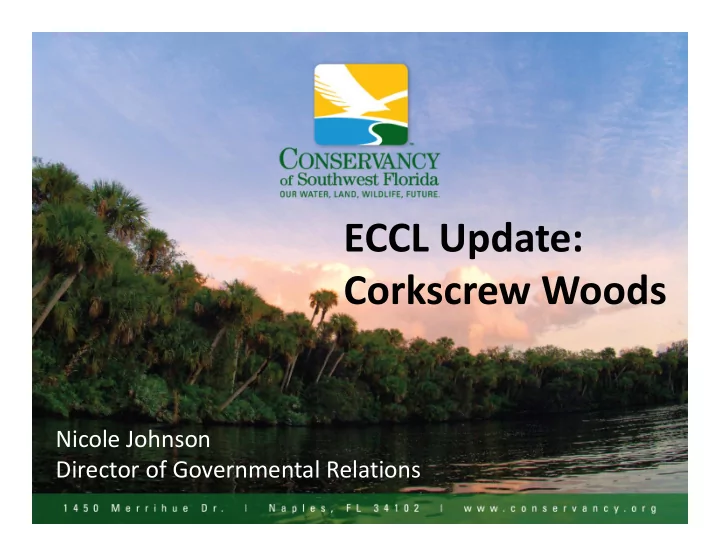

ECCL Update: Corkscrew Woods Nicole Johnson Director of Governmental Relations
Corkscrew Woods • 722 acres/222 acre lake Within the • Previously mined DR/GR • Vested for 254 single family lots Requesting • Site partially cleared Comp Plan and road base installed amendment and rezone to: Photo: Camaretta Companies • Reduce development footprint and lot size • Connect to water and sewer • Increase density
Project Proposal • 800 units (254 vested + 546 new) • Reduce footprint by 57 acres (through smaller lots) • Protect additional panther habitat • Hook up to water & sewer (instead of well and septic) Photo: Camaretta Companies The concern was not whether • Additional buffer to CREW lands this was a better concept for development, but how the • Irrigation from lake applicant acquired additional density • Lake improvements
Initial Concerns September 2011 application requested removal from DR/GR and placed in Sub ‐ Outlying Suburban Conservancy and ECCL expressed concerns: • Integrity of newly adopted DR/GR amendments • Policy precedent that would be set Photo: Camaretta Companies We advocated that all parties work • DR/GR has a mechanism to find a way to allow the for acquiring additional development to be approved while density – the TDR program keeping it in the DR/GR
Alternative Language Created for CPA The applicant, County staff and stakeholders all worked collaboratively to find a solution that would allow the development as proposed but keep the project in the DR/GR New Land Use Category within the DR/GR would be created “Improved Residential Communities” To be added to Map 17
Applicability is Limited Proposed Policy 33.3.3 would only apply in the following circumstances: • Properties having existing approvals inconsistent with current DR/GR density requirements • Properties that, if developed as vested, may damage surface and sub ‐ surface water resources • Properties that, if developed as vested, would impact habitat • Properties that, if developed as vested, would encroach on environmentally ‐ sensitive lands
Applicable Projects Must Meet the Following • Abut lands designated as future urban areas • Adjacent to and eligible for public water and sewer • Can provide 2 direct accesses to an arterial road • Not on Map 17 as Existing Acreage Subdivision or Mixed ‐ Use Community Staff, applicant, ECCL and Conservancy cannot find another property that could be eligible under these strict standards
After Eligibility Determined Property must be rezoned to RPD and demonstrate performance criteria, such as: • Reduced stress to onsite potable aquifer • Increase conservation area • Provide recreational opportunities for healthy living • Demonstrated net benefit for water resources • Enhanced lake management
How Additional Density is Obtained Menu of options provided: • Acquire offsite land and extinguish density • Acquire offsite conservation easements • Provide additional onsite conservation easements • Perform onsite restoration • Preserve primary panther habitat • Protect onsite wetlands connected to regionally significant flowways as identified in the Lee Plan • Provide funds to Lee County to extinguish density on other DR/GR parcels or to construct large mammal crossings in the DR/GR ($8500/ac) This last option was critical to Conservancy and ECCL support of the concept
As Applied to Corkscrew Woods In order to gain the necessary 546 additional units, the applicant must select from a number of the density ‐ increasing options, including payment of $8,500 per acre The exact amount of funding will be determined during rezoning, when density credits are verified But, it is anticipated that at least $1.2M will be contributed to future TDR purchase or large mammal crossings (150 units)
Where is this Project in the Process? LPA staff report released April 19 th Went to LPA on April 23 rd Both options remain – removal from DR/GR and remaining in DR/GR Staff, applicant, stakeholders all support LPA recommended remaining in DR/GR transmittal by the BoCC of staff’s alternative language Conservancy and ECCL raised questions/concerns about the mechanics of the new amendment Will meet with staff to discuss
Remaining in the DR/GR is the Best Alternative • Provides additional density bonuses based on additional environmental benefits • Allowed for TDRs to be purchased • Has as part of the menu Source: Camaretta Companies of options the ability for Creative thinking, hard work density to be gained and the willingness to through a per acre fee of collaborate can result in $8,500 solutions acceptable to all parties Will go to BoCC in June
Why Was an Alternative Necessary? During the DR/GR amendment process, Corkscrew Woods was assumed to be built as vested with 254 units on 1 ‐ acre lots It was never considered as an eligible site for intensification through the TDR program However, an alternative was also necessary because while the framework for a DR/GR TDR program is in place, the mechanics to make it work have yet to be created
Recommend
More recommend